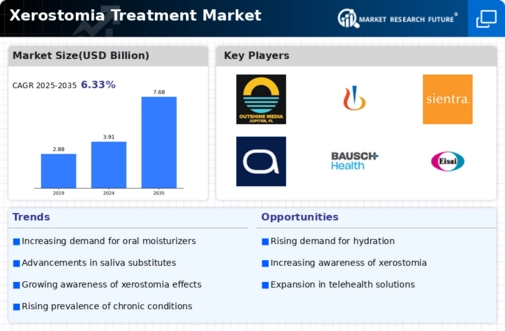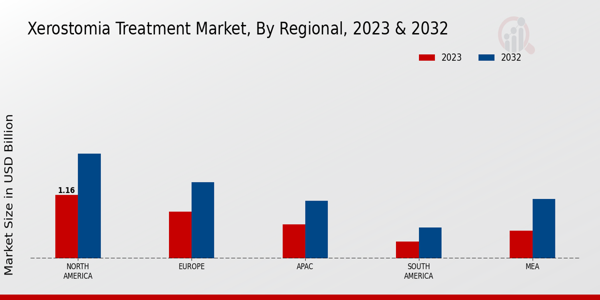Market Growth Projections
The Global Xerostomia Treatment Market is projected to experience substantial growth over the coming years. With an estimated market value of 3.91 USD Billion in 2024, the industry is expected to expand significantly, reaching approximately 7.68 USD Billion by 2035. This growth trajectory reflects a compound annual growth rate (CAGR) of 6.33% from 2025 to 2035. Such projections indicate a robust demand for effective xerostomia treatments, driven by various factors including an aging population, advancements in treatment options, and increased awareness of the condition.
Growing Awareness and Education
Increased awareness regarding xerostomia and its implications is driving the Global Xerostomia Treatment Market Industry. Healthcare providers are focusing on educating patients about the condition, its causes, and available treatments. Campaigns aimed at raising awareness about the importance of oral health have led to more individuals seeking treatment for xerostomia. This heightened awareness is likely to result in increased demand for therapeutic options, thereby expanding the market. As healthcare systems prioritize patient education, the Global Xerostomia Treatment Market is poised for growth, reflecting the need for effective management strategies.
Advancements in Treatment Options
Innovations in treatment modalities are significantly influencing the Global Xerostomia Treatment Market Industry. New products, such as saliva substitutes and stimulants, are being developed to enhance patient comfort and quality of life. For example, the introduction of advanced oral sprays and lozenges has improved the management of xerostomia symptoms. These advancements not only provide patients with more effective solutions but also expand the market's potential. As a result, the Global Xerostomia Treatment Market is expected to grow at a CAGR of 6.33% from 2025 to 2035, reaching an estimated 7.68 USD Billion by 2035.
Increasing Prevalence of Xerostomia
The rising incidence of xerostomia, or dry mouth, is a primary driver of the Global Xerostomia Treatment Market Industry. Factors contributing to this increase include aging populations and the widespread use of medications that cause dry mouth as a side effect. For instance, it is estimated that over 20% of older adults experience xerostomia, which correlates with the growing demographic of individuals aged 65 and older. This demographic shift is expected to propel the market, as the Global Xerostomia Treatment Market is projected to reach 3.91 USD Billion in 2024, indicating a strong demand for effective treatment options.
Rising Incidence of Chronic Diseases
The prevalence of chronic diseases, such as diabetes and autoimmune disorders, is contributing to the growth of the Global Xerostomia Treatment Market Industry. These conditions often lead to xerostomia as a side effect of treatment or the disease itself. For instance, individuals with diabetes may experience dry mouth due to fluctuating blood sugar levels or medication side effects. As the global population ages and the incidence of chronic diseases rises, the demand for effective xerostomia treatments is likely to increase. This trend underscores the importance of addressing xerostomia in the management of chronic health conditions.
Regulatory Support for Treatment Development
Regulatory bodies are increasingly supporting the development of new treatments for xerostomia, which is positively impacting the Global Xerostomia Treatment Market Industry. Initiatives aimed at expediting the approval process for innovative therapies are encouraging pharmaceutical companies to invest in research and development. This regulatory support not only facilitates the introduction of new products but also enhances competition within the market. As a result, the availability of diverse treatment options is expected to grow, catering to the needs of patients suffering from xerostomia.














